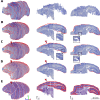Towards a comprehensive atlas of cortical connections in a primate brain: Mapping tracer injection studies of the common marmoset into a reference digital template
- PMID: 27099164
- PMCID: PMC4892968
- DOI: 10.1002/cne.24023
Towards a comprehensive atlas of cortical connections in a primate brain: Mapping tracer injection studies of the common marmoset into a reference digital template
Abstract
The marmoset is an emerging animal model for large-scale attempts to understand primate brain connectivity, but achieving this aim requires the development and validation of procedures for normalization and integration of results from many neuroanatomical experiments. Here we describe a computational pipeline for coregistration of retrograde tracing data on connections of cortical areas into a 3D marmoset brain template, generated from Nissl-stained sections. The procedure results in a series of spatial transformations that are applied to the coordinates of labeled neurons in the different cases, bringing them into common stereotaxic space. We applied this procedure to 17 injections, placed in the frontal lobe of nine marmosets as part of earlier studies. Visualizations of cortical patterns of connections revealed by these injections are supplied as Supplementary Materials. Comparison between the results of the automated and human-based processing of these cases reveals that the centers of injection sites can be reconstructed, on average, to within 0.6 mm of coordinates estimated by an experienced neuroanatomist. Moreover, cell counts obtained in different areas by the automated approach are highly correlated (r = 0.83) with those obtained by an expert, who examined in detail histological sections for each individual. The present procedure enables comparison and visualization of large datasets, which in turn opens the way for integration and analysis of results from many animals. Its versatility, including applicability to archival materials, may reduce the number of additional experiments required to produce the first detailed cortical connectome of a primate brain. J. Comp. Neurol. 524:2161-2181, 2016. © 2016 The Authors The Journal of Comparative Neurology Published by Wiley Periodicals, Inc.
Keywords: Nissl staining; brain template; cerebral cortex; digital atlas; image registration; marmoset; neuroanatomical tracing.
© 2016 The Authors The Journal of Comparative Neurology Published by Wiley Periodicals, Inc.
Conflict of interest statement
The authors declare no competing financial interests.
Figures









Similar articles
-
Histology-Based Average Template of the Marmoset Cortex With Probabilistic Localization of Cytoarchitectural Areas.Neuroimage. 2021 Feb 1;226:117625. doi: 10.1016/j.neuroimage.2020.117625. Epub 2020 Dec 8. Neuroimage. 2021. PMID: 33301940
-
Population-averaged standard template brain atlas for the common marmoset (Callithrix jacchus).Neuroimage. 2011 Feb 14;54(4):2741-9. doi: 10.1016/j.neuroimage.2010.10.061. Epub 2010 Oct 29. Neuroimage. 2011. PMID: 21044887
-
The NanoZoomer artificial intelligence connectomics pipeline for tracer injection studies of the marmoset brain.Brain Struct Funct. 2020 May;225(4):1225-1243. doi: 10.1007/s00429-020-02073-y. Epub 2020 May 4. Brain Struct Funct. 2020. PMID: 32367264
-
Current models of the marmoset brain.Neurosci Res. 2015 Apr;93:116-27. doi: 10.1016/j.neures.2015.01.009. Epub 2015 Mar 26. Neurosci Res. 2015. PMID: 25817023 Review.
-
Brain templates and atlases.Neuroimage. 2012 Aug 15;62(2):911-22. doi: 10.1016/j.neuroimage.2012.01.024. Epub 2012 Jan 10. Neuroimage. 2012. PMID: 22248580 Review.
Cited by
-
The nonhuman primate neuroimaging and neuroanatomy project.Neuroimage. 2021 Apr 1;229:117726. doi: 10.1016/j.neuroimage.2021.117726. Epub 2021 Jan 20. Neuroimage. 2021. PMID: 33484849 Free PMC article. Review.
-
Connectomes: from a sparsity of networks to large-scale databases.Front Neuroinform. 2023 Jun 12;17:1170337. doi: 10.3389/fninf.2023.1170337. eCollection 2023. Front Neuroinform. 2023. PMID: 37377946 Free PMC article. Review.
-
Mapping and comparing fMRI connectivity networks across species.Commun Biol. 2023 Dec 7;6(1):1238. doi: 10.1038/s42003-023-05629-w. Commun Biol. 2023. PMID: 38062107 Free PMC article. Review.
-
A connectomics-based taxonomy of mammals.Elife. 2022 Nov 7;11:e78635. doi: 10.7554/eLife.78635. Elife. 2022. PMID: 36342363 Free PMC article.
-
Intrinsic Functional Boundaries of Lateral Frontal Cortex in the Common Marmoset Monkey.J Neurosci. 2019 Feb 6;39(6):1020-1029. doi: 10.1523/JNEUROSCI.2595-18.2018. Epub 2018 Dec 10. J Neurosci. 2019. PMID: 30530862 Free PMC article.
References
-
- Amunts K, Lepage C, Borgeat L, Mohlberg H, Dickscheid T, Rousseau M‐É, Bludau S, Bazin P‐L, Lewis LB, Oros‐Peusquens A‐M, Shah NJ, Lippert T, Zilles K, Evans AC. 2013. BigBrain: an ultrahigh‐resolution 3D human brain model. Science 340:1472–1475. - PubMed
Publication types
MeSH terms
Grants and funding
LinkOut - more resources
Full Text Sources
Other Literature Sources
Miscellaneous

